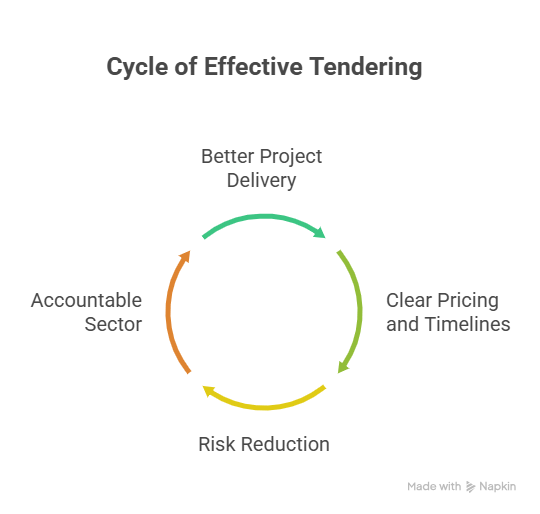How to Win High-Value Projects
Position your firm to secure more construction work by understanding and mastering tendering in construction.
From large public projects to complex engineering contracts, effective tendering isn’t just about lowest cost – it’s about proving you’re the right supplier or contractor to deliver.
This blog breaks down tendering strategies tailored for the construction industry – from understanding the process to writing winning bids.
In the competitive world of construction and the built environment, the way you tender can be the difference between growth and missed opportunities.
Whether you’re bidding for architectural tenders, urban design tenders, or civil engineering contracts, success depends on more than technical ability. It requires a strategic approach to bid writing, pricing, and positioning.
This guide covers the tendering process in construction, key stages, and how to develop a winning bid strategy. If your business is ready to elevate its success rate with compliant bids and intelligent submissions, read on.
What is Tendering in Construction?
Tendering in construction is the structured process of submitting a proposal to carry out a specific package of work, often defined in tender documents issued by a project owner. It’s commonly used in the public sector procurement process and private construction contracts.
Tendering involves preparing a comprehensive bid that outlines how your company will meet the scope, specifications, and deliverables of a particular project. It includes the submission of technical details, compliance evidence, pricing, and timelines.
Bid management teams handle this process, often supported by external bid writing services like The Glow Studio to ensure clarity, compliance and persuasive positioning. It’s not just paperwork; it’s a strategic sales document that must convince decision-makers you’re the best option.
The process invites bids from contractors or suppliers, with each company preparing a competitive offer based on specifications, timelines, and costs. The goal: to win the contract and deliver the construction work efficiently and profitably.
Why Tendering Matters
Tendering enables project owners – whether private developers, public authorities or main contractors – to find a qualified contractor through an open, transparent, and competitive method. It also ensures that the procurement process remains fair and cost-effective while selecting a suitable contractor with the right experience.
 How to Win Tenders in Construction
How to Win Tenders in Construction
Winning high-value bids requires more than filling out forms. It demands a strategic approach. Here’s how to stand out:
Tip: Most tenders fail due to non-compliance with instructions, generic answers that don’t address the brief, unrealistic pricing or timelines, weak evidence of relevant experience, poor presentation, and a lack of clear value proposition or client focus. Winning tenders are clear, compliant, and client-focused – not just cheap.
Common Types of Tendering
There are several types of tendering used in UK construction and globally:
- Open tendering process: Available to all interested contractors, often used in public sector procurement.
- Selective tendering: Limited to a shortlist of prequalified bidders.
- Negotiated tendering: Direct negotiation with a single supplier or contractor – common in design and build or management contracts.
- Two-stage tendering: Used for complex or high-value projects to allow early contractor involvement.
- Framework agreements: Long-term contracts with multiple suppliers for recurring services.
Each type of tendering process offers different advantages and disadvantages depending on project goals and procurement strategy.
Explore more in our construction blog series, including:
- Branding in Construction and the Built Environment
- Business Development for Construction Companies
- Thought Leadership in Construction
- Communicating CSR Initiatives in the Built Environment
The Advantages and Disadvantages of Tendering
Advantages:
- Transparent selection process
- Fair competition
- Cost efficiency for clients
- Market access for new and smaller contractors
Disadvantages:
- Time-consuming process in construction
- Can favour lowest cost over quality
- Difficult for newcomers to win without references
To overcome disadvantages, contractors must invest in bid strategy, build up credentials through smaller contracts, and maintain consistency in their submissions.
Ready to Improve Your Win Rate?
If your business is ready to stop chasing tenders and start securing them, The Glow Studio can help. Our strategic marketing and communications support construction companies across the UK – from bid documents to brand positioning.
Use our Contact Form to find out more about tendering in construction. Or review our industry page to find out how you can attract the Right Clients with our Built Environment Marketing.
Author: Lisa Barnett
Lisa B, our very own Head of Creative, leads our studio and produces strong, vibrant communications to tell a story and get results. Lisa loves to turn the mundane into something beautifully creative and her love of procedures and order is a great asset to the studio and ensures projects are managed with precision and clarity.
 How to Win Tenders in Construction
How to Win Tenders in Construction


